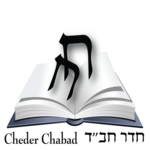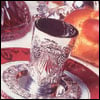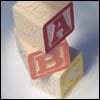In this section we shall present many of the practical applications of the laws of Bishul. This may involve some repetition of the above-stated principles but will be a useful summary for the student.
5:1 Serving Food from a Pot that Is Standing on the Fire
There are some Poskim who are of the opinion that one may not stir food (even if fully cooked) if it is standing on the fire (even if the fire is covered with a blech). The accepted practice is to be stringent and follow this opinion. As such, one may not serve food from a pot that is standing on the fire. The pot must be removed from the fire.1
Even when the pot has been removed from the fire it may not be stirred. However one may use a spoon to remove food from the pot — even from the bottom of the pot.2
In the case of a pot standing on a blech, it is not necessary to take the pot totally off the blech in order to serve. Rather, it is sufficient to move the pot onto a part of the blech that does not have the power to heat food to Yad Soledes Bo. The food may then be served, and afterwards the pot may be moved back to the part of the blech directly over the flame.3 If the pot is removed totally and one wishes to return the pot, then the rules of returning a pot to the fire — as explained in a later section — must be observed.
In all cases one must take care that when one removes the lid of a pot it should not become cold, for this would present a problem of re-heating the liquid on the underside of the lid. Obviously if the lid is removed for a few seconds just to view the contents, the lid would not become cold. However if the intention is to remove some of the contents of the pot, and the lid would be removed for some time, in which case the lid may become cold, then it may be preferable to keep the pot covered with the lid, and only remove it when actually removing the food. Alternatively, one could place the lid on the blech to keep it warm.
5:2 Covering a Pot with a Lid while the Pot Is on the Fire
An uncovered pot of partially cooked food may not be covered with a pot lid as this would speed up the cooking process. The lid holds in the heat and allows the food to cook faster, which is an act of Bishul. Therefore great care must be taken not to lift the lid off such a pot, as it would be prohibited to return the lid.
However, one may cover a pot of fully cooked food, even if by covering it one increases the bubbling.4
In practice, if one wishes for example to check the cholent on Friday night, one must make sure that it is fully cooked before the lid is removed. (Today one may purchase Pyrex/glass covers which solve this problem.)
5:3 Pouring Hot Water into a Wet Cup
a) If a cup has been rinsed under the tap, it should be dried5 before hot water is poured into it from a Keli Rishon.
b) If a dry cup was filled with hot water which has since cooled down, and one wishes to add more hot water, then:
1. if the remaining water is still warm (even though less than Yad Soledes Bo), more hot water may be added directly from the Keli Rishon, but,
2. if the remaining water has totally cooled down, the water must be emptied and the cup dried before adding more hot water.
c) Usually when making a hot drink in a Keli Shlishi, a dry cup is taken to use as a Keli Sheni to transfer the hot water from the Keli Rishon into the Keli Shlishi. If this Keli Sheni needs to be filled a few times in order to make a few cups of drink, it is not necessary to dry the cup every time. Rather, as soon as the water has been poured into the Keli Shlishi one may refill the cup without having to check to see that it is dry.6
As regards a thermos, see footnote.7
5:4 A Ladle
A ladle being used to serve soup should preferably be kept in the pot between servings. If the ladle was removed and the droplets of soup on the ladle have cooled down, then the ladle must be dried before reinsertion into the pot.
5:5 Adding More Food to a Wet Keli
If one wishes to add:
a) more hot soup from a Keli Rishon to soup remaining in a Keli Sheni, or
b) more cholent to a plate with cholent remains, then, if the remains are still warm, the soup/cholent may be added. However, if the remains are cold, a new bowl/plate should be used.
5:6 Adding Salt to Food
a) One may not add salt to a hot, dry food in a Keli Rishon; however, salt may be added to hot, dry food in a Keli Sheni.8
b) One may only add salt to a hot liquid if it is in a Keli Shlishi (or by Irui Keli Sheni). Therefore practically, one may only add salt to hot chicken soup if the bowl is a Keli Shlishi.9 The same would apply to cholent.
5:7 Adding Baked Food to Hot Liquids
Bread, biscuits or matzah may not be added to a Keli Rishon or Sheni. Therefore one may not dip a biscuit into a cup of tea that is in a Keli Sheni, nor may one add matzah to chicken soup in a Keli Sheni. It is permitted in a Keli Shlishi (or Irui Keli Sheni).10
5:8 Lokshen
Dry cooked lokshen may be put into a Keli Rishon that has been removed from the fire. (Of course it may be placed in a Keli Sheni or placed in a bowl, with soup then added with a ladle.)
If the lokshen is wet to the touch, it may not be placed in a Keli Rishon. However, it may be placed in a Keli Sheni or placed in a bowl, with soup then added with a ladle.11
5:9 Soup Nuts
Soup nuts that are deep-fried may be added to a Keli Sheni (or even a Keli Rishon removed from the fire). However, soup nuts that are baked may not even be placed in a Keli Sheni because of Bishul Achar Afiyah. However, they may be placed in a Keli Shlishi (or Irui Keli Sheni). If in doubt as to how the soup nuts were processed, only add to soup in a Keli Shlishi.12
5:10 Making Coffee
A cup of coffee should be made on Shabbos in the following way:
1. Take a dry cup. If the cup has been rinsed, it should be dried.
2. Fill the cup with hot water from the kettle.
3. The hot water should then be poured into a second cup (a Keli Shlishi) in which one then puts the coffee granules.
There are opinions that allow instant coffee, milk and sugar to be added to a Keli Sheni, however it is always preferable to use a Keli Shlishi.
5:11 Making Tea
a) Instant tea should be prepared in the same way as coffee (Irui Keli Sheni) as stated above.
b) Many people prepare a tea essence before Shabbos (i.e., they pour hot water onto a few tea bags13 in a tea pot, allow it to brew, and then remove the bags. Some then place the pot on the blech). This essence, hot or cold, may be added to a Keli Sheni.
c) Tea Bags. One may make tea on Shabbos using a tea bag inside a Keli Shlishi. As regards removing the tea bag, one should not remove it with one’s fingers but with a spoon.14 Furthermore, one should not squeeze the bag upon removal from the cup.15
d) Herbal teas in a bag must be prepared in a Keli Shlishi.
e) As regards placing a slice of lemon in the tea, see footnote.16
5:12 Adding Hot Water to Tea/Coffee
If the tea/coffee was prepared as above, and it has cooled below Yad Soledes Bo but is still warm enough to drink as a hot drink, then one may add hot water directly17 from the kettle.18
Note that a tea bag was used to make the tea, and the tea bag is still in the cup, one may not add hot water from the kettle.19
5:13 Instant Powdered Soups
Most instant soup powders have been already completely cooked and therefore may be prepared using an Irui Keli Sheni or in a Keli Shlishi.20
5:14 Instant Mashed Potatoes
Instant mashed potatoes may be made in a Keli Shlishi. However a thin mixture should be made and it must be mixed employing a shinui.21 See Section 5:17.
5:15 Ketchup
Ketchup may be added to a hot solid, e.g., meat, hot potatoes, etc., if the solid is in a Keli Shlishi.22
5:16 Frozen Foods
A frozen liquid23 should not be placed in a warm place in order to melt it, even though there is no possibility it will be heated to Yad Soledes Bo. However, if needed for a child, one may be lenient.24
For example, if one needed to feed some frozen soup to a baby, it may be placed near a fire to warm slightly.25 However, this is only permitted in an area where even if it were left for a while it would not reach the temperature of Yad Soledes Bo. In an area where it would reach Yad Soledes Bo — even after an hour — the soup may not be placed even for a minute.26
5:17 Food Preparation for a Child
a) Milk Powder
Milk powder for a baby should be prepared using an Irui Keli Sheni, i.e., fill a dry cup with hot water from the kettle and then pour the water onto the powder inside the baby’s bottle.
b) Instant Cereal
Instant cereals should be prepared using an Irui Keli Sheni.27
Since it is prohibited on Shabbos to create a thick mixture (this being the Melachah of Losh/Kneading), when preparing cereals on Shabbos, one must take care to make a thin mixture and use a shinui (an unusual method). Therefore:
1. If during the week one would usually put the cereal in the bowl first and then add the liquid, the order must be reversed on Shabbos; i.e., first pour the liquid in the bowl and then add the cereal.
2. The mixture should be mixed with a spoon employing an unusual method; e.g., instead of moving the spoon around the bowl in a circular movement as would normally be done on a weekday, the mixing should be done in a criss-cross manner.28
c) Warming a Bottle of Milk
A baby’s bottle of cold milk may be placed in a Keli Sheni to warm up. This would be permitted even if the temperature of the milk would rise above Yad Soledes Bo.29
Alternatively, one may make an Irui Keli Rishon onto the outside of the bottle.30
One may also place a bottle of milk that has been in the refrigerator and is too cold to give the baby, near the fire so as to warm it slightly.31 (See Section 5:16) Near the fire means near the blech, but under no circumstances may the bottle be placed on the blech.
5:18 Eggs and Onion Mixture
In making an eggs and onion mixture on Shabbos there are a number of issues to be considered:32
a) Peeling the eggs and onion: Due to the prohibition of Borer, the peeling must be done immediately prior to the meal.
b) The peels are muktzeh and may not be moved. Ideally, the eggs should be peeled over the garbage in a way that the shells fall into the garbage as the egg is peeled. (Alternatively, one may place a piece of challah33 inside a bowl and then peel the eggs into the bowl — the piece of challah allows the bowl to be carried although it contains the egg shells — as explained in the dinim of muktzeh).
c) If the egg is stamped, one should be careful not to break the shell where the stamp is — this is due to the prohibition of erasing writing.
d) Grinding — It is preferable to cut the onion into pieces larger than the norm. This is due to the Melachah of Tochain/Grinding. However if one needs to chop very finely, this should be done close to the meal.34
e) The egg (or liver — if added) may not be ground using a grinder or masher, i.e., a specific utensil for the purpose of grinding.
f) Mixing — One should employ a shinui (an unusual method) when mixing the egg/oil/onion mixture. First, one should place the oil in the plate and then the other ingredients. When mixing, one should do so using criss-cross movements.
g) One should not smoothen the surface of the mixture due to the prohibition of Memarei’ach/Smoothing.
h) One should not build the mixture into shapes.
5:19 Washing Netilas Yadayim
When washing Netilas Yadayim, one should be careful that no water splashes onto a blech, hotplate or hot pot, and becomes cooked.
Furthermore, after drying one’s hands, one must be careful not to place the towel on a hot radiator. This would cause the water to evaporate and hence an act of Bishul.
5:20 Adding Hot Water to cholent
See Section 8:7.








Join the Discussion